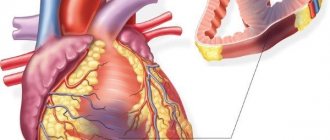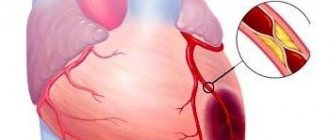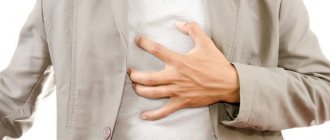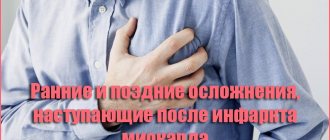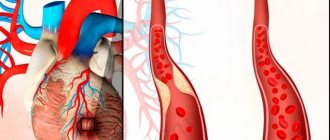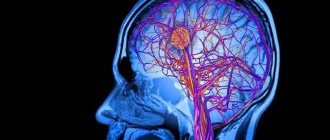Acute death of the heart muscle is an emergency. In approximately 10-70% it is lethal. Such a wide range is due to many factors that influence the prognosis of development and outcome.
According to statistics, among the stronger sex, acute coronary insufficiency (or heart attack) occurs in most cases. The ratio compared to women is 3-4:1 and even higher according to some sources.
The symptoms of myocardial infarction in men under and over 50 years of age do not differ - this is a group of manifestations from the cardiovascular system, kidneys, excretory tract as a whole, mental activity, and also the brain.
You can recognize deviations on your own; you need to be attentive and listen to how you feel. However, the final word remains with the medical staff.
The main recommendation is not to take risks, do not experiment on yourself. Call an ambulance and, if necessary, go to the hospital for examination and comprehensive treatment and rehabilitation.
Signs of the prodromal stage
Simply put, manifestations that precede an approaching heart attack. Acute necrosis of cardiac structures develops differently in men and women, which is associated with hormonal characteristics and hemodynamics.
If for representatives of the weaker sex the process is extended over time over weeks, there are cases when signs appeared in a month, for the stronger half there is a maximum of 6-7 days. Sometimes there is no prodrome at all.
What signs should you be particularly wary of:
- Shortness of breath after minor physical activity. Indicates that the heart cannot cope with the load and is not able to provide the body, muscles, and brain with an adequate amount of oxygen. It is considered a relatively late sign and worsens as the emergency approaches.
- Fatigue, weakness, drowsiness. I don’t want to do anything, and I don’t have the strength. Everything is falling out of hand. When performing habitual actions, increased fatigue occurs and you have to put in more effort. The productivity of mental processes and thinking drops significantly. There is a feeling of softness in the body, of the unreality of everything that is happening around.
- Depression. A characteristic, early trait. If the classic clinical form of dysthymia occurs over a long period of time or is preceded by some kind of traumatic situation, stress, then everything is spontaneous. There are no objective reasons. According to statistics, mental disorders of this kind in men are considered harbingers of a heart attack 5 times more often than in women. It is not known whether this is a cause or an effect.
- Nausea, vomiting, digestive disorders. Disruption of the gastrointestinal tract. Dyspeptic phenomena. Like heartburn, belching, increased intestinal gas. Possible constipation and diarrhea, alternation of processes.
- Aching bones and malaise are another harbinger of a heart attack, although not specific. All indications of influenza symptoms. It speaks of ischemia of muscle fibers and insufficient metabolic rate. An alarming early sign, which is also not obvious, it is difficult to link it with an upcoming heart attack.
- Dizziness. Inability to navigate in space. It speaks of a disruption in the supply of cerebral structures and nervous tissues in general. It develops at once and lasts from a couple of minutes to an hour. Attacks occur repeatedly over a short period. Including one day in difficult situations.
- Chest pain. Dull, oppressive. Less often burning. It lasts only a short time, so it’s impossible to react immediately. It radiates to the jaw, left arm, shoulder blade, back, teeth, face, stomach. It is difficult to link pain syndrome and heart attack. It is well disguised as discomfort in the digestive tract.
- Unexplained dysfunction of erectile function and sexual desire. It occurs spontaneously and is manifested by the inability to achieve stable potency or impaired ejaculation already during sexual intercourse.
Specific studies by an andrologist show a pronounced deviation of the organic plan. If you conduct a penile tumescence test, Doppler sonography with provocation of an erection, insufficient filling of the cavernous bodies with blood is detected due to weak arterial blood flow.
- Impaired attention, thinking, memory. Cognitive and mnestic functions. Absent-mindedness, inability to concentrate on an object or thing.
The duration of the prodromal period is about 4 days, sometimes less. The first signs of a heart attack in men (precursors) are nonspecific, arising from the cardiovascular, nervous, reproductive systems, and mental activity.
What is myocardial infarction?
Modern means of self-defense are an impressive list of items that differ in their operating principles. The most popular are those that do not require a license or permission to purchase and use. In the online store Tesakov.com, you can buy self-defense products without a license.
Myocardial infarction is one of the most severe clinical forms of IHD (coronary heart disease), which is accompanied by death (necrosis) of a section of the myocardium resulting from the cessation of blood supply to one of the sections of the heart muscle. Such a violation of the coronary circulation, lasting for 15 minutes or more, occurs due to complete or relative blockage of one of the branches of the coronary vessels by an atherosclerotic plaque or thrombus. As a result, myocardial cells die, and it is this affected area of the heart muscle that is called myocardial infarction (see Fig. 1).
Rice. 1 - Myocardial infarction is an affected area of the heart muscle.
Subsequently, the death of a section of the myocardium leads to oxygen starvation of the heart muscle and disruption of the normal functioning of the cardiovascular system as a whole. The patient experiences severe pain in the sternum or heart, which is not eliminated even by taking nitroglycerin, and in the absence of timely medical care, this condition can lead to the death of the patient.
Symptoms of the most acute stage
The actual emergency condition develops in a matter of hours. The first sign of a heart attack in men and the most characteristic is acute, intense pain in the chest. The patient cannot show where exactly. Only an approximate area.
Discomfort may be reflected (reflected) to the stomach, cheekbones, teeth, left arm, collarbone, shoulder blade or back in general. As necrosis progresses, the symptom disappears and weakens. A period of false prosperity begins.
An option with “medium” pain is possible, but it lasts over 30 minutes. A duration exceeding half an hour is the main sign that distinguishes a heart attack from angina pectoris.
Other symptoms:
- Dyspnea. Inability to take in air. Intensifying pulmonary activity does not make sense. The disorder occurs due to a decrease in cardiac output into the systemic circulation. The organs simply do not have enough nutrients and oxygen. This is a compensatory mechanism, but it is obviously flawed. It gives nothing but discomfort. After the onset of a heart attack, shortness of breath accompanies the patient at rest and intensifies against the background of minimal physical activity. Changes in body position, walking and other moments.
- Paleness of the skin. As a result of reflex stenosis of the capillary network. There is a disturbance in the peripheral flow of liquid tissue and nutrition. Hence the change in the shade of the dermis. The man looks like a wax figure. Rubbing and physical methods have no effect.
- Cyanosis of the nasolabial triangle. Pronounced blue discoloration around the mouth and lips. The color of the nail plates and mucous membranes also changes; a violation of the pigmentation of the gums is especially indicative due to weakening of blood flow and vasospasm.
- Mental disorders of a transient nature. First - a panic attack. Severe fear that does not subside even after relief of the condition, psychomotor agitation, increased motor activity. The patient cannot sit in one place. He is anxious and rushes about. May pose a danger to yourself.
Then stupor sets in. The person is lethargic, does not respond to external stimuli, and is silent. Depending on the type of personality, a heart attack can start with mental “stagnation”.
- Loss of consciousness. Neurological sign. Indicates insufficient blood circulation in the brain. Rarely found in isolation. It goes in combination with other signs. Such as headache, vertigo. The discomfort is pressing, pulling, localized in the back of the head, crown, and temporal region. It taps, knocks, and pulsates in time with the beat of the heart. Additionally, disorientation in space occurs due to dizziness.
- Nausea and vomiting. Parts of one whole. The signs are reflexive in nature. The nutrition of special centers of the brain is disrupted. Ischemia entails the generation of chaotic signals. Episodes of gastric emptying do not end with relief as with poisoning. This is a reflex, and it occurs even when the gastrointestinal tract is empty, regardless of food intake.
- Arrhythmia. Tachycardia, then a decrease in contraction frequency to a level of 40-50 beats per minute.
The typical clinical picture is observed in 87-89% of cases.
The process is less active and aggressive, compared to the variant in women, and less often ends in death even in the most difficult situations.
Diagnosis and treatment
According to the guidelines of the American College of Cardiology, treatment of patients with unstable angina (pre-infarction) and non-ST segment elevation myocardial infarction is carried out in full without gender differences. But in practice, men are more often exposed to invasive medical procedures:
- coronary angiography;
- percutaneous coronary interventions.
Among medications, the stronger sex is prescribed dual antiplatelet therapy with less caution, since their risk of bleeding is lower compared to women. It consists of the use of Aspirin at a dose of ≥ 75 mg per day and Clopidogrel - 75 mg per day. The alternatives are:
- "Ticagrelor"
- "Prasugrel"
- "Cangrelor"
- "Ticlopidine."
Beta blockers can negatively affect potency.
Atypical forms of MI
So-called atypical forms of heart attack are possible. The essence remains the same, the symptoms differ.
Asthmatic appearance
- Severe suffocation. This is not an acceleration of the process, but an inability to take in air as a result of a spasm of the tract, trachea and bronchi. It also produces neurological symptoms: darkening of the eyes, dizziness, and lightheadedness. All signs of acute cerebral ischemia. May result in a stroke. We need urgent help to restore gas exchange.
- Inability to lie down for the same reason.
- Hoarse, wheezing breathing. Gurgling in the chest. Symptom of developing pulmonary edema.
- Non-productive cough. No phlegm. Possibly with some blood, but not right away. A few hours later.
- Chest pain is completely absent.
Abdominal form
Gives signs of acute abdomen. Falsely leads doctors to think about appendicitis, colitis, perforation of the intestinal walls, obstruction, and other conditions including peritonitis.
Symptoms:
- Abdominal pain of an unbearable, pressing or cutting nature.
- Forced position of the body in this regard, to relieve discomfort.
- Nausea, vomiting.
- Paleness, hyperhidrosis (excessive sweating).
- Decrease or increase in body temperature.
The picture is so convincing that even experienced specialists need time for differential diagnosis. Specific tests - Shchetkin-Blumberg, Lenander and others are negative. Which gives food for thought. Ultrasound also shows no changes.
The patient is transported to the cardiology hospital. You can suspect something is wrong based on the following characteristic features:
- There is also chest pain. This is not the case with an acute abdomen.
- There is instability of cardiac activity.
- Blood pressure is unstable.
- There is a history of cardiovascular disorders.
Arrhythmic form
Easier to recognize. There is also usually no pain, or it is so scarce that it does not attract attention. But there are obvious violations of myocardial contractility:
- Feeling of pressure in the chest, missing beats, slowing down, stopping.
- Sweating.
- Impaired consciousness.
The arrhythmic form of heart attack most often provokes a stroke and occurs in men over 60 years of age. The parallel course of emergency conditions - necrosis of brain tissue and infarction - gives a worse prognosis. Therefore, at the first sign of a violation, you need to call an ambulance.
First aid
Signs of myocardial infarction in men are very variable, so for any unexplained pain, discomfort, or unusual symptoms, always call an ambulance. An examination by a cardiologist and an ECG will allow you to remove or confirm the diagnosis.
If you have a history of coronary heart disease, carry nitroglycerin with you.
When someone experiences signs that resemble the first signs of a heart attack, action must be taken quickly. Remember, necrosis of the heart muscle can be prevented only in the first 20-45 minutes after vessel thrombosis. In case of acute myocardial ischemia, there are 6–12 hours to prevent complications.
First aid for myocardial infarction:
- place the man on a hard surface;
- remove all constrictive clothing, loosen your tie;
- open the windows to provide access to fresh air;
- place a nitroglycerin tablet under your tongue;
- call an ambulance;
- if the pain does not subside and the ambulance has not arrived, give nitroglycerin three times, with an interval of 5 minutes, while measuring blood pressure to prevent hypotension;
- give an aspirin tablet 0.25–0.5 g and ask the man to chew it;
- try to reassure the patient, instill confidence that help is close;
- do not give any antihypertensive drugs until the doctors arrive;
- put your documents (passport, insurance policy, data from previous examinations) in a visible place so as not to waste time after the ambulance arrives.
First aid measures for yourself are the same.
How to distinguish heart pain from another
Difference on your own is possible, but only approximately. It is worth paying attention to the nature of the pain, intensity, duration, and other manifestations.
General principles:
- Cardiac discomfort does not change its properties when standing up, bending, deep breathing, coughing, sneezing. Possible intensification due to physical activity and stress. They are well treated with Nitroglycerin, but if there is any suspicion, drinking it without medical approval is not recommended.
- Choking is not a typical sign of a heart attack. If arrhythmias are present, the cause is definitely in the heart. Abdominal discomfort also rarely causes cardiac symptoms or manifestations from the nervous system.
Clinical picture of the acute period
The total duration of a heart attack is from 8 to 24 hours. Then comes stagnation of the condition and gradual regression, recovery or death of the patient from developed complications.
Help should start early: before 6 hours. When finished, the moment is called late or acute. 12-18 hours - subacute. Therefore, signs in the interval from 6 to 12 hours are considered.
The picture is blurred, although the typical moments are still present:
- The pain becomes weak, burning, pressing. It goes away or remains to an insignificant extent. This is good only if the therapy is carried out. If there is no medical intervention, there is a high risk of extensive necrosis and death of nerve endings.
- Arrhythmia type bradycardia. Reducing heart rate to 40 beats per minute. In critical situations even lower.
- Drowsiness, weakness. Loss of consciousness. Deep fainting. In some cases, they can turn into comatose states. Death is just around the corner, the cerebral structures do not receive nutrients and oxygen. They move into the phase of saving, “conservation”. Getting a person out of such a situation is not easy, sometimes even impossible.
- Paleness of the skin.
- Lack of urination. Oliguria. A bad sign, indicating a violation of the filtering function of the kidneys. Fluid retention and an increase in circulating blood volume forces the heart to work harder. The beginning of copious urine discharge after a heart attack is considered a favorable sign. This is evidence of normal functioning of the excretory tract.
- Coughing up blood. No sputum, mucous exudate.
- Mild headaches, vertigo.
- General lethargy, apathy. Indifference to everything around, insignificant reaction to external stimuli. The psychiatric status is abnormal, indicating a decrease in activity.
Possible spontaneous cessation of heart contractions, asystole. The patient's calmness and absence of complaints do not indicate the norm. Rather about the severity of the condition.
Only in the case of a microinfarction is it possible to reverse the process independently without dire consequences. And that's not always the case.
Possible consequences of a heart attack
The consequences of this pathology, like its symptoms, are divided into two groups: early (acute) and late.
Early ones occur immediately after disruption of blood flow in the coronary vessels, if timely therapy is not carried out.
- Acute heart failure is a sudden inability of the heart muscle to supply blood to internal organs and tissues. Appears with an extensive heart attack, when a large area of the myocardium dies.
- Rupture of the heart wall - thinned, dead muscle is damaged and torn due to blood pressure on it.
- A vessel aneurysm is a sac-like protrusion of its wall, which can also rupture.
- Arrhythmia is a disturbance in the rhythm of the heartbeat.
- Pericarditis is inflammation of the heart sac.
- Thromboembolism is a blockage of a vessel by a blood clot detached from the heart cavity. As a result, the development of ischemic stroke of the brain (deterioration of blood flow in the cerebral arteries) is possible.
The most common late complication of a heart attack is Dressler's syndrome, an autoimmune lesion of internal organs.
- Pericarditis is inflammation of the outer lining of the heart.
- Pleurisy is a lesion of the membrane covering the lungs.
- Pneumonitis is an inflammatory process in the lung tissue.
When pericarditis occurs, the patient feels pain in the chest and has shortness of breath. You can see swelling of the veins of the neck, enlargement of the abdomen due to the accumulation of transudate in it, asymmetry of the abdominal wall due to enlargement of the liver.
Symptoms of pleurisy include chest pain, decreased breathing, and cyanosis of the skin.
It is also possible to develop recurrent (up to two months) and repeated myocardial infarction or microinfarction (after two months).
source
How to help at home?
It is impossible to do this fully. Immediately after signs appear that even vaguely resemble necrosis, you need to call an ambulance.
It is impossible to recognize a heart attack with 100% accuracy on your own, but you need to report suspicions to the emergency dispatcher, this will help guide the doctors, they will arrive faster.
Before the ambulance arrives, the assistance algorithm is as follows:
- Open a window or vent to ensure normal ventilation of the room. This is necessary to partially compensate for hypoxia. If you continue to sit in high concentrations of CO2, the likelihood of a stroke increases, as does the worsening of cardiac necrosis itself.
- Sit down, don’t move again.
- Keep calm. Pull yourself together. Panic attack and fear are normal behavioral reactions. But they are unnecessary. Since the disturbance of the emotional background also has a physical dimension: cortisol and adrenaline are produced. Blood pressure and heart rate increase. Is it dangerous.
- Loosen the tight collar. Remove the cross, chain, body jewelry. Pressure on the carotid sinus, which is located near the carotid artery, will lead to a decrease in heart rate and cause death.
- Lower your legs and arms. Do not move your limbs, so as not to disturb the already fragile hemodynamics.
Upon arrival of the medical team, tell about the condition, do not hide anything. Brief and to the point.
It is advisable to inform relatives or friends about your situation. Ideal if there is someone nearby. He will help the team open the door and provide first aid if necessary.
How to recognize the first signs in time?
Precursors of an impending heart attack (or, as it is sometimes called, a heart attack) are divided into early and late.
Early symptoms occur a week before an acute circulatory disorder in the heart muscle. Their peculiarity is that they are nonspecific and can manifest themselves in diseases that have nothing to do with the cardiovascular system in general.
Therefore, patients often do not pay any attention to them, and this is a very big mistake, because according to statistics, when the acute phase develops, more than 30% of people do not survive until the ambulance arrives.
The first signs of a heart attack in men are as follows:
- Fatigue, severe weakness.
- Minor pain in the chest that is not associated with physical activity.
- Dizziness, which may be accompanied by nausea and vomiting.
- A condition similar to an acute viral infection - chills, muscle pain, aching bones.
- Mental disorders – anxiety, depressive mood, emotional instability.
- Pain in the lower jaw, neck, upper chest, the cause of which the patient cannot explain.
- Breathing problems after minor physical exertion.
The acute phase of a heart attack (late symptoms) occurs when a coronary artery becomes blocked and blood flow to the heart is reduced. Most often, the symptoms are classic.
The patient suddenly feels severe, burning pain behind the sternum, which radiates to the left side of the body (jaw, shoulder blade, arm). He begins to choke. Moreover, the appearance of these sensations is in no way connected with physical activity; pain is also present in a state of complete rest.
Circulatory disorders are characterized by activation of the sympathetic nervous system. The increased release of adrenaline leads to increased heart rate and a sharp increase in blood pressure. But the strength of the heart muscle is quickly depleted, so the pulse and blood pressure drop if timely help is not provided.
This is the classic course of a heart attack, which manifests itself in men 40, 45, 50 years old.
But there are also atypical cases of the disease. They are especially typical for young people, 30–35 years old.
The main unusual symptoms of a pre-infarction condition are presented below:
- Aching, squeezing pain that looks like an “elephant sitting on the chest.”
- Autonomic disorders - sweating, pale skin of the body, gray face, numbness of the limbs.
- Pain that radiates to the right side of the body.
- Sharp abdominal pain, nausea and vomiting.
- Fear of approaching death, panic attacks.
- Pain that is predominantly concentrated in the left biceps and shoulder.
- A sharp rise in blood pressure in people who have never suffered from hypertension.
- Occasionally, body temperature rises and skin rashes appear.
Due to the abundance of different symptoms, it is sometimes difficult to recognize when a heart attack begins. But the asymptomatic form of the disease is most dangerous. Nothing bothers the person; he endures the circulatory disorder literally on his feet.
In such cases, the patient learns that he had a heart attack only when complications develop. This condition is most typical for patients over 60–70 years of age. This is due to the fact that older people have reduced body reactivity and pain sensitivity.
Another reason for the “silent” course of a heart attack is blockage of a very small diameter vessel that supplies blood to a small area of the heart wall. “Mini heart attacks” do not have serious consequences for the patient. The victim finds out about it by chance when the presence of a scar is determined on a preventive electrocardiogram.
It will also be useful to know that there are a number of factors that increase the likelihood of developing a heart attack.
The main prerequisites and their symptoms are presented in the table below:
| Risk factor | Characteristic manifestations |
| Hypertensive | A sustained increase in systolic and diastolic blood pressure above 140/90, a crisis course of hypertension. |
| Atherosclerotic | Deposition of fatty plaques on the inner wall of the vessel, which leads to headaches, dizziness, discomfort in the lower extremities, changes in the psyche and intellect. |
| Angina pectoris | Periodic ischemia of the heart muscle, which manifests itself as pain in the sternum with excessive increased load and is eliminated by taking nitrates. |
What you should absolutely not do
- Move, exercise. With a slightly symptomatic course of the pathological process, the patient’s behavior may not be entirely adequate. Any loads are excluded.
- Wash. At all. Reflex vasoconstriction can lead to cardiac arrest. The expansion will end with increased peripheral blood flow and insufficient nutrition of the brain and the myocardium itself.
- Take medicine. Even Nitroglycerin, if this possibility was not discussed with the doctor. There is also a downside to the effect of the drug. Against the background of acute processes, it leads to disruption of myocardial nutrition and increases the risk of death.
- Go to the bath, shower.
- Try to cope on your own. No chance. Doctor's help, most likely hospitalization, is vital.
- Eating. Loss of consciousness and vomiting are possible. Aspiration, asphyxia, death.
- Go to bed. Gas exchange will weaken, which will lead to even greater necrosis.
Symptoms of a heart attack in men develop in a matter of minutes (excluding the prodrome). They are quite typical, but the doctors have the final say.
Calling an ambulance increases the chances of survival and full recovery. It is advisable that treatment begins within the first 4-6 hours. The outcome is maximally favorable, and then decreases in proportion to the time lost.
Differences from symptoms in women
The difference in heart attack symptoms in men and women is explained by different constitutional characteristics and hormonal levels.
Signs of the acute phase of the disease are in most cases similar for both sexes, with the exception of only some male characteristics. But the early signs are much more different.
The comparison is presented in this table:
| Early manifestations in women | Early manifestations in men |
| Heart rhythm disturbances: tachycardia, atrial fibrillation, extrasystole | Symptoms similar to acute viral infection |
| Swelling in the lower extremities | Prolonged increase in pressure |
| Frequent and copious urination | Breathing disorder |
| Prolonged depression | Anxiety, depression |
| Numbness and pain in the left upper limb | Aching and dull pain in the chest |
At the same time, the first signs of myocardial ischemia in women appear a month before the acute phase, and in men they can be seen a maximum of a week.
It is characteristic that depressive disorders, mood swings and increased fatigue are 3 to 4 times more likely to be observed in males.
As for the asymptomatic or silent course of this pathology, it occurs in both women and men.
